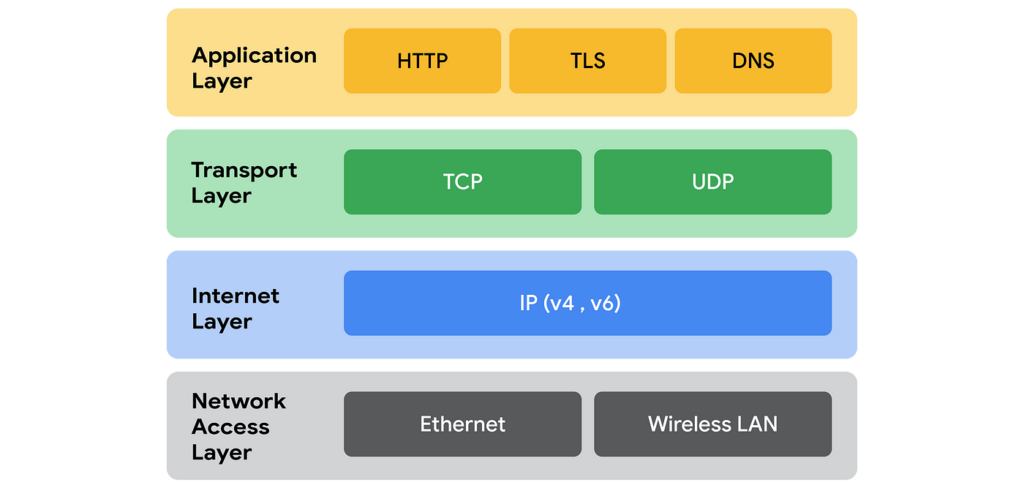The Transmission Control Protocol/Internet Protocol (TCP/IP) suite is the foundation of modern internet communication. It’s a set of networking protocols that govern how data is transmitted across networks, ensuring reliable and efficient delivery. Whether you’re browsing the web, sending emails, or streaming videos, TCP/IP is working behind the scenes to make it all happen.
Understanding the TCP/IP Model
The TCP/IP model is a framework that divides network communication into four layers:
- Application Layer: This layer is closest to the user and is responsible for handling application-specific protocols like HTTP (web), SMTP (email), and FTP (file transfer).
- Transport Layer: This layer provides logical communication between application processes running on different hosts. The two main protocols at this layer are TCP (Transmission Control Protocol) and UDP (User Datagram Protocol).
- Network Layer: This layer is responsible for addressing and routing data packets across networks. The Internet Protocol (IP) is the primary protocol at this layer.
- Link Layer: This layer deals with the physical transmission of data over a specific network medium, such as Ethernet or Wi-Fi. It includes protocols like Ethernet and ARP (Address Resolution Protocol).

Key Protocols in TCP/IP
- TCP (Transmission Control Protocol): TCP is a connection-oriented protocol that provides reliable, ordered, and error-checked delivery of data. It’s used for applications that require guaranteed data delivery, such as web browsing, email, and file transfer.
- Real-World Example: When you download a file from the internet, TCP ensures that all data packets arrive in the correct order and without errors. If a packet is lost, TCP retransmits it until it’s successfully received.
- UDP (User Datagram Protocol): UDP is a connectionless protocol that provides a simple, unreliable datagram service. It’s used for applications that prioritize speed over reliability, such as video streaming and online gaming.
- Real-World Example: During a video call, UDP is used to transmit audio and video data in real-time. If a few packets are lost, it’s not a big deal because the video can continue to play smoothly.
- IP (Internet Protocol): IP is responsible for addressing and routing data packets across networks. It provides a logical addressing scheme that allows devices to be uniquely identified on a network.
- Real-World Example: When you send an email, IP ensures that the email is routed from your computer to the recipient’s email server, even if they are located on different continents.
IP Addresses Recap
You already know about IP Addresses – it’s the first part of this module!
An IP address is a unique numerical label assigned to each device connected to a computer network using the Internet Protocol for communication. There are two versions of IP addresses:
- IPv4 (Internet Protocol version 4): The most common version, consisting of four numbers ranging from 0 to 255, separated by periods (e.g., 192.168.1.1).
- IPv6 (Internet Protocol version 6): A newer version with a larger address space, consisting of eight groups of four hexadecimal digits separated by colons (e.g., 2001:0db8:85a3:0000:0000:8a2e:0370:7334).
TCP/IP in Action
Let’s illustrate how TCP/IP works with a real-world example:
Imagine you’re sending an email to a friend. Here’s how TCP/IP comes into play:
- Application Layer: Your email client (e.g., Outlook, Gmail) uses the SMTP protocol to format and prepare the email for transmission.
- Transport Layer: TCP breaks the email into smaller packets and adds sequence numbers and checksums to ensure reliable delivery.
- Network Layer: IP adds the source and destination IP addresses to each packet and routes them through various networks to reach your friend’s email server.
- Link Layer: The data packets are converted into electrical or optical signals and transmitted over the physical network medium (e.g., Ethernet cable, Wi-Fi).
- The process is reversed on the receiving end, with the packets being reassembled into the original email and delivered to your friend’s inbox.
TL;DR:
- TCP/IP is the foundation of internet communication.
- The TCP/IP model divides network communication into four layers.
- TCP and UDP are the main transport layer protocols.
- IP is responsible for addressing and routing data packets.
- IP addresses uniquely identify devices on a network.